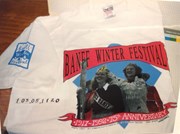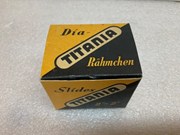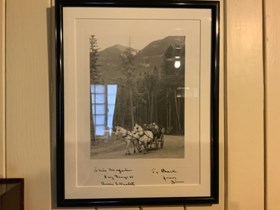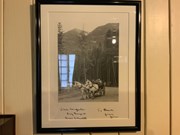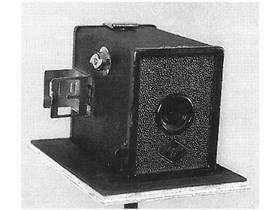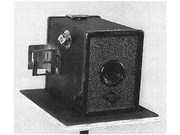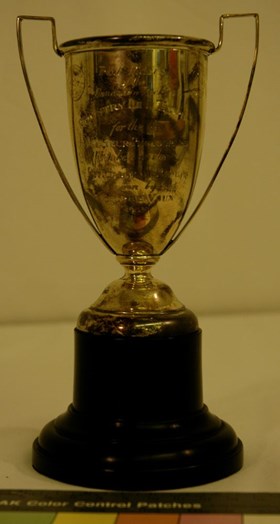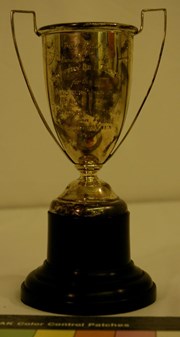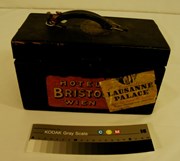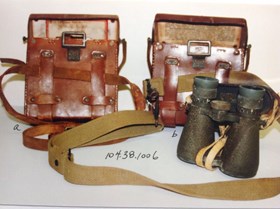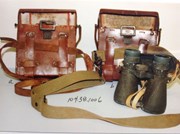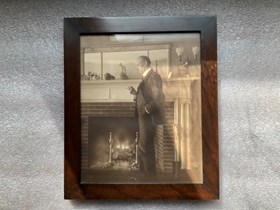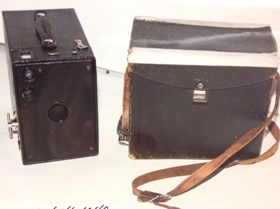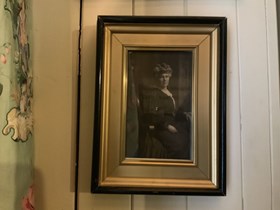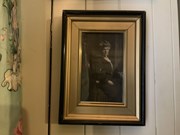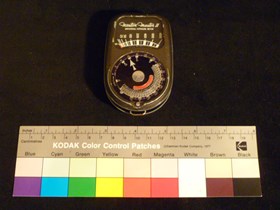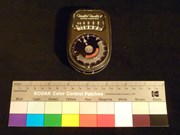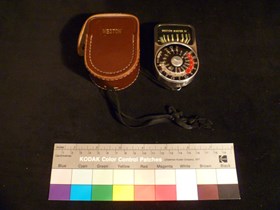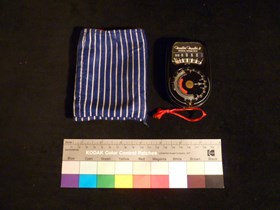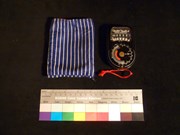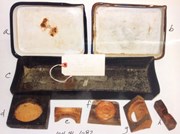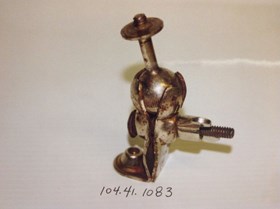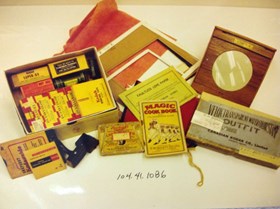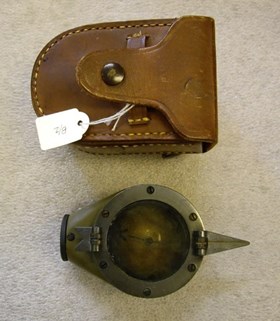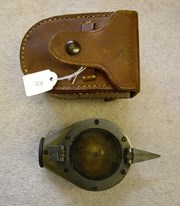Narrow Results By
- Date
- 1995
- Material
- leather; metal; wood; plastic
- Catalogue Number
- 104.41.0081 a-d
- Description
- Case: Manufacturer label on inside of lid reads G.R. TAYLOR LTD. TRUNKS & SAMPLE CASES WINNIPEG. No manufacturer details available online. Case is triangular in shape with a central carrying handle and metal clasps located along the narrow upper edge - one side of the case folds down. Padded suppor…
1 image
- Title
- Camera Tripod
- Date
- 1995
- Material
- leather; metal; wood; plastic
- Dimensions
- 28.3 x 28.6 x 138.5 cm
- Description
- Case: Manufacturer label on inside of lid reads G.R. TAYLOR LTD. TRUNKS & SAMPLE CASES WINNIPEG. No manufacturer details available online. Case is triangular in shape with a central carrying handle and metal clasps located along the narrow upper edge - one side of the case folds down. Padded supports and buckled leather straps located inside to keep the tripod in place - straps not done up at time of processing. NICHOLAS MORANT written in white along the narrow top edge on either side of carrying handle, TR1 written in yellow paint in the top left end of narrow edge and in top right corner of opening side, the torn remains on a Canadian Pacific Railway label remains on the side that does not open. Tripod: Manufacturer mark on metal support below the camera support base reads [D]INEMA EQUIPMENT CO. No manufacturer details available online. Tripod dimensions are 124.1x14.7x14.7 cm. The legs of the tripod are wood, with metal spikes at the bottoms, metal brackets, and a metal camera support rig [possibly cast iron]. The legs are held together with a buckled strip of leather at the bottom. Also in the case is a metal pole with a black plastic handle that can screw into the camera support base for use as a controller and a plastic zip-lock baggie containing a length of chain with 4 metal clasps throughout 286.0 cm in length.
- Credit
- Gift of Nicholas Morant, Banff, 2006
- Catalogue Number
- 104.41.0081 a-d
Images
This material is presented as originally created; it may contain outdated cultural descriptions and
potentially offensive content.
Read more.
- Date
- 1992
- Material
- fibre
- Catalogue Number
- 103.05.1120
- Description
- White t-shirt with a coloured copy of Bill Gibbons photograph of Banff Winter Festival crowning of the Queen. The right sleeve bears the “Banff Winter Festival” logo in blue and white. The photograph is boardered with banners reading “Banff Winter Festival” and “1917 - 1992 75th Anniversary.”
1 image
- Title
- T-Shirt
- Date
- 1992
- Material
- fibre
- Description
- White t-shirt with a coloured copy of Bill Gibbons photograph of Banff Winter Festival crowning of the Queen. The right sleeve bears the “Banff Winter Festival” logo in blue and white. The photograph is boardered with banners reading “Banff Winter Festival” and “1917 - 1992 75th Anniversary.”
- Credit
- Gift of Alex Emond, Banff, 1992
- Catalogue Number
- 103.05.1120
Images
This material is presented as originally created; it may contain outdated cultural descriptions and
potentially offensive content.
Read more.
- Date
- 1991
- Material
- plastic; cardboard
- Catalogue Number
- 105.05.0016
- Description
- Unused box of slide binders. Box is yellow, black, and beige with German and English writing. Inside are 20 square plastic slides with white fronts and black backing. Small piece of paper with instructions in German, English, and French.
1 image
- Title
- Slide Binder
- Date
- 1991
- Material
- plastic; cardboard
- Dimensions
- 5.5 x 6.5 x 5.5 cm
- Description
- Unused box of slide binders. Box is yellow, black, and beige with German and English writing. Inside are 20 square plastic slides with white fronts and black backing. Small piece of paper with instructions in German, English, and French.
- Subject
- Whyte home
- photography
- slides
- Credit
- Gift of Catharine Robb Whyte, O. C., Banff, 1979
- Catalogue Number
- 105.05.0016
Images
This material is presented as originally created; it may contain outdated cultural descriptions and
potentially offensive content.
Read more.
Photographic Print
https://archives.whyte.org/en/permalink/artifact105.02.0041
- Date
- 1939 – 1939
- Material
- paper; wood; glass; metal
- Catalogue Number
- 105.02.0041
- Description
- A black and white photograph of the King and Queen, in a carriage drawn by two white horses driven by Jim Brewster, with tall trees and mountains in background. The photo has a white mat and a simple black wooden frame. The bottom of the mat is marked “Thier (sic) Majesties King George VI Queen E…
1 image
- Title
- Photographic Print
- Date
- 1939 – 1939
- Material
- paper; wood; glass; metal
- Dimensions
- 22.7; 37.2 (frame) x 17.5; 29.6 (frame) cm
- Description
- A black and white photograph of the King and Queen, in a carriage drawn by two white horses driven by Jim Brewster, with tall trees and mountains in background. The photo has a white mat and a simple black wooden frame. The bottom of the mat is marked “Thier (sic) Majesties King George VI Queen Elizabeth” and “To Pearl from Jim.”
- Credit
- Gift of Pearl Evelyn Moore, Banff, 1979
- Catalogue Number
- 105.02.0041
Images
This material is presented as originally created; it may contain outdated cultural descriptions and
potentially offensive content.
Read more.
- Date
- 1938
- Material
- metal; glass; paper
- Catalogue Number
- 104.41.1113 a,b
- Description
- A simple black box camera with black, simulated textured leather. It also has an adhesive-taped, original box. The inverted aperture in the front has a black metal retention ring surrounding it. Below this “Agfa” is imprinted on the camera, surrounded by a diamond-shaped box. There is a black metal…
1 image
- Title
- Box Camera
- Date
- 1938
- Material
- metal; glass; paper
- Dimensions
- 8.5 x 6.5 cm
- Description
- A simple black box camera with black, simulated textured leather. It also has an adhesive-taped, original box. The inverted aperture in the front has a black metal retention ring surrounding it. Below this “Agfa” is imprinted on the camera, surrounded by a diamond-shaped box. There is a black metal rim which overlaps the edges on the front of the camera; on both sides there is a slight extension, .03 x.05 wide, 2.0cm from the top, with a hole in the metal. This fits over two small metal knobs on each side of the camera body. It appears that pushing the knobs in and pulling, would release the front part of the camera from the body. On the viewer’s left is the metal shutter release; a small metal lever that can be pulled down to release the shutter and expose the lens from inside the body. On the same side is the metal film winder, 3.0cm from the front and .50cm from the top; this is a flat piece of metal 2.0cm in diameter, with arrows indicating the direction to turn (clockwise arrows), a round raised metal tab, onto which is screwed a piece of metal (2.5cmx1.0cm wide in the middle) to wind the film. It can also be pulled out to release the metal film chamber. The metal is turned down on the side of each end so the fingers can grasp it for turning. A metal folding viewfinder is .50cm from the back and 2.7cm from top and bottom; a flat piece of metal 3.0cm sq., folded at the sides, is rivetted onto the body. Two flat metal pieces are attached at each end, one on a spring to fold down; this piece is 2.4x2.7cm wide with a window cut out .50x1.0cm wide. The other piece is 2.7cm sq. with a window of 1.5x2.4cm wide; the cutout has a piece of metal raised from the bottom of the window. The cutout is for perspective when you look through the viewfinder, vertically or horizontally. This piece of metal folds down to become the top, effectively making the viewfinder flat when not in use. There is a hinged door on the back of the camera and a cut-out metal latch on the door that connects to a small metal knob 1.0cm from the edge of the body. There is a red circle film window (1.0cm diagonally) which lets you read the frame number on the film. On the inside of the door are two rivets that connect the hinge. Above that and below the red circle, is a white painted circle with “USE AB” printed in black, overlapping a painted orange, blue, white, and yellow Agfa Plenachrome film box. The red viewfinder is 4.0cm from the base. A metal film chamber, with two metal rollers on each end for winding the film on, fits inside the camera. It can be released by pulling out the film winder. The canister is 7.0x5.0 wide, is open at one end, hollow in the centre, sloping upwards with a circular hole at the other end to let light in. There are two sprockets sitting on two cutouts on top of the canister and two on the bottom, onto which the film is winded. There are two rivets attaching two Y-shaped metal pieces, on either end that guide and let the film move and roll. The top of the camera has two metal knobs 1.5cm crosswise from each end, where a leather strap with a hole on either end, .07cm from the edge, fits in to make a diagonal strap/handle for carrying. The strap is imprinted with “A-8 CADET”. There is a small metal pull-up tab, 1.0cm from the edge of the front of the camera, that lets you time the shutter speed.
- Subject
- households
- photography
- hobbies
- Bob Louden
- Credit
- Gift of Bob Louden, Calgary, 2004
- Catalogue Number
- 104.41.1113 a,b
Images
This material is presented as originally created; it may contain outdated cultural descriptions and
potentially offensive content.
Read more.
- Date
- 1933
- Material
- metal; wood; fabric; paper
- Catalogue Number
- 103.09.1226
- Description
- A two-handled sterling silver trophy cup on a turned wooden base; the cup is in its original blue flannel drawstring bag. A black label with “BIRKS” in gold is stitched to the bag. The engraving on the front of the cup “Trail Riders of the Canadian Rockies” is in italic script, underneath, engraved…
1 image
- Title
- Loving Cup
- Date
- 1933
- Material
- metal; wood; fabric; paper
- Dimensions
- 18.5 x 9.2 cm
- Description
- A two-handled sterling silver trophy cup on a turned wooden base; the cup is in its original blue flannel drawstring bag. A black label with “BIRKS” in gold is stitched to the bag. The engraving on the front of the cup “Trail Riders of the Canadian Rockies” is in italic script, underneath, engraved in an arc in caps “COUNTRY LIFE TROPHY” (all other engraving is printed horizontally) lc italics “for the best”, caps “AMATEUR PHOTOGRAPHY “ lc italics “taken on the”, caps “OFFICIAL TRAIL RIDE”, lc italics “won by”, caps “GEORGE VAUX”, “1933”. The TRCR logo (a circle with a horse and rider in the centre surrounded by a rim in which “TRAIL RIDERS OF THE CANADIAN ROCKIES” is printed) is stamped on both sides of engraved “Trail Riders of the Canadian Rockies”. On the back of the cup near the lip and to the right an engraved “BIRKS” surrounded by a box, ”STERLING”, three silver hallmarks, “66/23”. The handles rise up 1.5 cm. from the lip, 1.5cm. horizontally and then curve down gracefully to the bottom of the cup at the narrowest part. The base of the cup flares out and is attached to a black turned wooden base. The bottom of base is covered by glued on black faux leather (paper).
- Subject
- sports
- riding
- horses
- Trail Riders of the Canadian Rockies
- Country Life Trophy
- George Vaux
- photography
- Credit
- Gift of Molly Vaux, New York, USA, 2007
- Catalogue Number
- 103.09.1226
Images
This material is presented as originally created; it may contain outdated cultural descriptions and
potentially offensive content.
Read more.
- Date
- 1931
- Material
- metal; wood
- Catalogue Number
- 103.09.1183
- Description
- Two handled silver-plated cup on black wooden circular base. Cup engraved: “Trail Riders of the Canadian Rockies Photographic Contest 1931”.
1 image
- Title
- Loving Cup
- Date
- 1931
- Material
- metal; wood
- Dimensions
- 23.0 cm
- Description
- Two handled silver-plated cup on black wooden circular base. Cup engraved: “Trail Riders of the Canadian Rockies Photographic Contest 1931”.
- Credit
- Gift of John Fee, White Rock, 1996
- Catalogue Number
- 103.09.1183
Images
This material is presented as originally created; it may contain outdated cultural descriptions and
potentially offensive content.
Read more.
Lantern Slide Box
https://archives.whyte.org/en/permalink/artifact104.41.1315%20a-c
- Date
- 1931
- Material
- wood; varnish; metal; paper; felt; plastic
- Catalogue Number
- 104.41.1315 a-c
- Description
- three lantern slide boxes:(a) rectangular wooden box with lid hinged on one long side and two hooks on the opposite side; Dark brown varnish coating; rabbet joinery; on one of the box small sides, there is a Dymo label with archival number: “V353 / PS 1 - 78” above a yellowed label with red frame w…
1 image
- Title
- Lantern Slide Box
- Date
- 1931
- Material
- wood; varnish; metal; paper; felt; plastic
- Dimensions
- (a) 12.0 ; (b) 12.5 ; (c) 14.4 x (a) 12.2 ; (b) 12.2 ; (c) 12.7 x (a) 32.0; (b) 32.7; (c) 33.0 cm
- Description
- three lantern slide boxes:(a) rectangular wooden box with lid hinged on one long side and two hooks on the opposite side; Dark brown varnish coating; rabbet joinery; on one of the box small sides, there is a Dymo label with archival number: “V353 / PS 1 - 78” above a yellowed label with red frame with number 19 in top left corner, circled in green and print: “LEACOCK SLIDES / 1925 - 1931 / 1 - 78”; black pen handwritten number “191” in top left corner of small side; three square compartments inside with sides padded with green felt(b) similarly built box to (a) with smaller dimensions ; Dymo label on one small side with archival number: “V353 / PS 79 - 156”; Black pen handwriting on the lid’s side: “191 LEACOCK / 79 - 156”; number 191 circled in green(c) rectangular wooden box with lid hinged on one long side and two hooks on the opposite side; dark brown varnish coating; dovetail joinery; on one of the box small sides, there is a Dymo label with archival number: “V353 / PS 157 - 234” above a yellowed label with red frame and number 19 in top left corner, circled in green and print: “LEACOCK SLIDES / 1925 - 1931 / 157 - 234”; three square compartments inside with sides padded with Bordeaux felt
- Credit
- Gift of Glenbow Archives, Calgary, 1995
- Catalogue Number
- 104.41.1315 a-c
Images
This material is presented as originally created; it may contain outdated cultural descriptions and
potentially offensive content.
Read more.
- Date
- 1930
- Material
- skin; wood; metal; glass; paper
- Catalogue Number
- 104.41.1114 a-f
- Description
- A Cine-Kodak movie camera with a case, a lens cover, a metal spool (empty), a paper box with a tin (empty) for returning film for processing, an instruction booklet and a card for exposure times:(a) A slim compact black movie camera Model B-B with a f1.9 lens. On one side it has an oblong “OPEN” an…
1 image
- Title
- Movie Camera
- Date
- 1930
- Material
- skin; wood; metal; glass; paper
- Dimensions
- 11.5 x 5.5 x 21.0 cm
- Description
- A Cine-Kodak movie camera with a case, a lens cover, a metal spool (empty), a paper box with a tin (empty) for returning film for processing, an instruction booklet and a card for exposure times:(a) A slim compact black movie camera Model B-B with a f1.9 lens. On one side it has an oblong “OPEN” and “LOCK” mechanism in the middle and to the right it is monogrammed in gold “P.D.G”. On the opposite side is the black metal winder (to wind up the spring for film) the metal exposure tab, and the half-speed button. On the top is the carrying handle, the pop-up sight finder, the pop-up viewfinder and the indicator which moves from 50 degrees to 0. This is at the bottom of a black metal piece with silver lettering “CINE-KODAK MODEL BB MADE IN U.S.A. BY EASTMAN KODAK COMPANY ROCHESTER N.Y.”. At the other end is the lens with the focusing scale engraved for 2 to 50 ft and INF. (infinity) and the metal piece with the exposure guide screwed on “FOR CLOSE UPS IN SHADE” and a line to denote 4... to f16 “SEE MANUAL” “FOR USE IN THE TROPICS SEE MANUAL”. The camera opens on the side exposing the metal spool container the spring, the sprockets etc.(b) the leather-covered, felt-lined carrying case with a handle. The oblong shaped case is 24.0x 12.5cm wide and 14.0cm high, has compartments inside for the camera, film etc. and a hinged lid. The outside has a coloured travel sticker for “Passionsspiele Oberammergau” pasted to the the cover under the handle. To the viewer’s left a travel sticker for “Lausanne Palace”, the front “Hotel Bristol Wien” and pasted over that to the right another sticker for “Lausanne Palace”; on the right side a half-torn sticker with “AN” and underneath “IC”.(c) a black plastic and metal lens cover with “BALDA” written on it in script.(d) a yellow and black box with an empty metal film container inside. The box has the address “CANADIAN KODAK CO. LTD TORONTO 9 ONTARIO” on the front of the box on the side it has “DEVELOP BEFORE DEC. 1955”. (e) metal spool with “CINE KODAK SPOOL PAT. IN U.S.A. 1507 357”.(f) an instruction book, a booklet and a card for exposure times.
- Subject
- hobbies
- photography
- movie camera
- Credit
- Gift of Rae McIntyre, Jasper, 1985
- Catalogue Number
- 104.41.1114 a-f
Images
This material is presented as originally created; it may contain outdated cultural descriptions and
potentially offensive content.
Read more.
- Date
- 1917
- Material
- skin; fibre; metal; glass; paper
- Catalogue Number
- 104.38.1006 a,b
- Description
- Two pair binoculars in leather cases. Binoculars of dark green metal marked: “CARL ZEISS. JENA. Fernglas 08” Pair (a) has “Nr. 26615” & “IV 1917” and pair (b) marked “Nr. 31134” & “V 1917”. Both cases have label of German text inside lid. Case (a) has a label on top of original label which reads: “…
1 image
- Title
- Binoculars
- Date
- 1917
- Material
- skin; fibre; metal; glass; paper
- Dimensions
- 14.5 x 8.0 x 17.5 cm
- Description
- Two pair binoculars in leather cases. Binoculars of dark green metal marked: “CARL ZEISS. JENA. Fernglas 08” Pair (a) has “Nr. 26615” & “IV 1917” and pair (b) marked “Nr. 31134” & “V 1917”. Both cases have label of German text inside lid. Case (a) has a label on top of original label which reads: “Please return to: George Vaux Jr. Gulph Rd. Bryn Mawr. Penna. U.S.A.” Case (a) has leather strap and case (b) has a canvas strap.
- Subject
- photography
- Vaux family
- sports
- hiking
- tourism
- military
- Credit
- Gift of Molly Vaux, New York, USA, 1999
- Catalogue Number
- 104.38.1006 a,b
Images
This material is presented as originally created; it may contain outdated cultural descriptions and
potentially offensive content.
Read more.
Photograph Print
https://archives.whyte.org/en/permalink/artifact105.02.0100
- Date
- 1915
- Material
- paper; wood; metal
- Catalogue Number
- 105.02.0100
- Description
- Black and white photograph of a man standing in front of an ornate fireplace. He is dressed in a three piece suit with a watch chain and is smoking a cigarette. He is in profile and is looking downwards and is quite pensive looking. Photograph is framed in a dark wooden frame, has wire for hanging…
1 image
- Title
- Photograph Print
- Date
- 1915
- Material
- paper; wood; metal
- Dimensions
- 23.0 x 28.0 cm
- Description
- Black and white photograph of a man standing in front of an ornate fireplace. He is dressed in a three piece suit with a watch chain and is smoking a cigarette. He is in profile and is looking downwards and is quite pensive looking. Photograph is framed in a dark wooden frame, has wire for hanging on wall. Marks: on framer's label on back "No. 20626 Doll & Richards Incorporated 71 Newbury St. Boston". Hand written in ink "Russell Robb 1915".
- Subject
- households
- photography
- Russell Robb
- Credit
- Gift of Catharine Robb Whyte, O. C., Banff, 1979
- Catalogue Number
- 105.02.0100
Images
This material is presented as originally created; it may contain outdated cultural descriptions and
potentially offensive content.
Read more.
- Date
- 1914
- Material
- wood, paperboard, glass, metal
- Catalogue Number
- 104.41.1040
- Description
- Kodak box camera with case; regular box camera; body made of cardboard with wood back and front; holein front is lens and shutter, 2 windows top corner for viewfinders top andside; 2 pull posts, one for aperture, other to keep shutter open; shutterrelease on right hand side, along with film advance…
1 image
- Title
- Box Camera
- Date
- 1914
- Material
- wood, paperboard, glass, metal
- Dimensions
- 17.1 x 14.3 x 11.0 cm
- Description
- Kodak box camera with case; regular box camera; body made of cardboard with wood back and front; holein front is lens and shutter, 2 windows top corner for viewfinders top andside; 2 pull posts, one for aperture, other to keep shutter open; shutterrelease on right hand side, along with film advance knob; round amber window in back; back detached; cardboard box covered with cloth; flap comes over toplatches at clip which has "Brownie" in fancy letters, also has a leather strapon the case.
- Subject
- photography
- Hubert Green
- Credit
- Gift of Hubert E. Green Jr., Banff, 1986
- Catalogue Number
- 104.41.1040
Images
This material is presented as originally created; it may contain outdated cultural descriptions and
potentially offensive content.
Read more.
Photographic Print
https://archives.whyte.org/en/permalink/artifact105.02.0031
- Date
- 1913 – 1913
- Material
- paper
- Catalogue Number
- 105.02.0031
- Description
- A black and white studio photograph of a woman (Isabella Thompson Brewster) with black dress sitting in wooden chair with a carved back.
1 image
- Title
- Photographic Print
- Date
- 1913 – 1913
- Material
- paper
- Dimensions
- 15.8 x 9.5 cm
- Description
- A black and white studio photograph of a woman (Isabella Thompson Brewster) with black dress sitting in wooden chair with a carved back.
- Credit
- Gift of Pearl Evelyn Moore, Banff, 1979
- Catalogue Number
- 105.02.0031
Images
This material is presented as originally created; it may contain outdated cultural descriptions and
potentially offensive content.
Read more.
Exposure Meter
https://archives.whyte.org/en/permalink/artifact104.41.1118
- Date
- 1888
- Material
- metal; paint; plastic
- Catalogue Number
- 104.41.1118
- Description
- Hand held exposure/light meter made by Weston Electrical Instrument Company in a grey metal finish. Along both sides of the meter are a series of protruding lines that allow one to safely grip the object. At the bottom of the artifact there is a metal hook, which would have allowed a string to be a…
1 image
- Title
- Exposure Meter
- Date
- 1888
- Material
- metal; paint; plastic
- Dimensions
- 2.0 x 6.0 x 9.5 cm
- Description
- Hand held exposure/light meter made by Weston Electrical Instrument Company in a grey metal finish. Along both sides of the meter are a series of protruding lines that allow one to safely grip the object. At the bottom of the artifact there is a metal hook, which would have allowed a string to be attached like on the other Weston meter’s owned by Nicholas. There is also no longer a case to protect this particular object. In the top of the exposure meter there is a clear plastic covering. Along the very top there us the name of the manufacturer in white cursive lettering that reads “Weston Master II” and written underneath in capital letters “UNIVERSAL EXPOSURE METER.” Below this is the light scale where the value of the scene would be indicated. The scale contains the values “0” “25” “50” “100” “200” “400” “800” “1600,” which means that the two values on this instrument are calibrated 0-50 and 0-1600. (candles per square foot.)Below there is a circular face with several figures and a dial that turns/rotates. The outside row of figures on the exposure control dial represents the light value settings and corresponds to the light values on the light scale. Below the round dial there is a tiny circular button that is used to set the exposure control dial for film speed. As the dial turns it reveals the “EMULSION SPEED” with a red baize finish that has become worn throughout its life. The row of figures at the bottom of the top dial is the f/stop values and has an “f” to make this more apparent for the user. The row of figures directly below the f/stop settings are the shutter speeds. After setting the exposure control dial to the light value obtained on the light scale, any of the combinations of f/stop and shutter speed directly opposite each other are correct. On the rear of the meter there is a black plastic covering that contains several circular cut outs that are called a hir.ged baffle. This can be swung open (against the case) using the gold latch, which clips into a tiny hole or socket when the user wishes it to be closed. When opened the light sensitive photo cell is directly beneath this baffle and contains several protruding circles. When the baffle is open, the scale range is 0-50; when the baffle is closed, the scale range is 0-1600. Below there is an oval shaped face with extensive information that is held in place with two small screws on both the viewer left and right side. There is silver lettering on a black background that reads “WESTON ELEC. INST. CORP.” “NEWARK, N.J., U.S.A.” A silver backing separates the patent information and has black writing that reads “MODEL 735” on the viewer left side. On the viewer right side the number “7454510” is engraved. In the middle there is a gold-coloured screw with the words “ZERO CORRECTOR” written in black. Below this there is the patent information; “U.S. PATENTS” “2,274,441” “2,073,790” “2,346,555” “2,137,466” “2,463,770.” Below these numbers are the “FOREIGN PATENTS” “FRENCH 862,770” “BRITISH 531,996” “CAN. 347,085” “CAN. 411,975” At the very bottom underneath there is the manufacturer’s location; “MADE IN U.S.A.”
- Subject
- photography
- Nick Morant
- Credit
- Gift of Nicholas Morant, Banff, 2006
- Catalogue Number
- 104.41.1118
Images
This material is presented as originally created; it may contain outdated cultural descriptions and
potentially offensive content.
Read more.
- Date
- 1888
- Material
- leather; metal; nylon; plastic; thread; paint
- Catalogue Number
- 104.41.1119 a-b
- Description
- Hand held light meter in a pear shape with a stainless steel body and leather case. Along both sides of the meter are a series of protruding lines that allow one to safely grip the object. On the viewer right there is a pointer lock, which is locked when positioned upwards and released when positio…
1 image
- Title
- Exposure Meter
- Date
- 1888
- Material
- leather; metal; nylon; plastic; thread; paint
- Dimensions
- 2.0 x 5.0 x 9.0 cm
- Description
- Hand held light meter in a pear shape with a stainless steel body and leather case. Along both sides of the meter are a series of protruding lines that allow one to safely grip the object. On the viewer right there is a pointer lock, which is locked when positioned upwards and released when positioned downward. At the bottom of the artifact there is a metal hook, which has a black string running through. In the top of the light meter there is clear plastic covering. Written in capital letters is “WESTON MATER IV” above the light scale. The lights scale contains the numbers “0” “25” “50” “100” “200” “400” “800” “1600,” which means that the 2 values calibrated on this instrument are 0-50 and 0-1600.Below there is another light scale in the form of a circular face with several figures and a dial that turns/rotates. The dial on the outside has a series of protruding lines to make movement easier and contains a row of figures. This dial controls the lens aperture (f/stop) scale and has a series of values representing the focal length of the lens; “1” “1.4” “2” “2.8” “4” “5.6”. On the same dial there is also the letters “EVS,” which stands for the exposure value setting with a cut out window that reveals the EVS values. Working in a clockwise direction (on the same dial) there is also the letters “U,” “A with “1/2” over top,” an enclosed arrow that is known as the normal arrow, a “C” with “2x” on top of it, and a “0”. As this dial is turned it reveals a partly red baize and black numbers on a silver background that represents the shutter speeds in fractions of seconds. The inside dial has a series of light scale values and an exposure index window that line up with the “U,” “A,” normal arrow, “C,” and “0.” On the opposite side of the exposure index window is the exposure index knob. On the rear of the meter there is a black plastic covering that contains several circular cut outs that are called a hir.ged baffle. This can be swung open (against the case) using the gold latch, which clips into a tiny hole or socket when the user wishes it to be closed. When opened the light sensitive photo cell is directly beneath this baffle and contains several protruding circles. When the baffle is open, the scale range is 0-50; when the baffle is closed, the scale range is 0-1600. Below there is an oval shaped face with extensive information that is held in place with two small screws on both the viewer left and right side. There is black lettering on a silver background that reads “UNIVERSAL EXPOSURE METER” “MODEL 745” SER.W” and “107522” engraved. Below the manufacturer information is listed; “DAYSTROM. INCORPORATED” “WESTON INSTRUMENTS DIVISION”. “NEWARK. N.J.. U.S.A.” In the middle there is a gold-coloured screw with the words “ZERO CORRECTOR” written in black. On the viewer left side of the zero corrector there is patent information; “U.S. PATENTS” “2463770” and on the viewer right side “FOREIGN PATS” “CAN. 411975”. At the very bottom on either side of a circular cut out are “ASA” and “K=1.0” written. Underneath “MADE IN JAPAN” has also been written.There is also a brown leather case with this object. The front has “WESTON” written in gold letters. On the viewer left there is a brown button that allows the case to be opened or fastened shut. The leather has been stitched together with light brown thread that is visible. The bottom of the case has an opening for the black string to be strung through so that the light meter and case are attached. On the rear there is a brown leather strap stitched.
- Subject
- photography
- Nick Morant
- Credit
- Gift of Nicholas Morant, Banff, 2006
- Catalogue Number
- 104.41.1119 a-b
Images
This material is presented as originally created; it may contain outdated cultural descriptions and
potentially offensive content.
Read more.
- Date
- 1888
- Catalogue Number
- 104.41.1120 a-b
- Description
- Hand held light meter in a pear shape with a stainless steel body and leather case. Along both sides of the meter are a series of protruding lines that allow one to safely grip the object. At the bottom of the artifact there is a metal hook, which has a red string running through.There is a clear p…
1 image
- Title
- Exposure Meter
- Date
- 1888
- Description
- Hand held light meter in a pear shape with a stainless steel body and leather case. Along both sides of the meter are a series of protruding lines that allow one to safely grip the object. At the bottom of the artifact there is a metal hook, which has a red string running through.There is a clear plastic covering located at the top of the meter. Written in cursive letters is the company name “WESTON MATER II”. Underneath this written in capital letters is “UNIVERSAL EXPSOURE METER”. The light scale underneath contains the numbers “0” “25” “50” “100” “200” “400” “800” “1600,” which means that the 2 values calibrated on this instrument are 0-50 and 0-1600. Underneath the scale the word “Light” is present. Below there is another light scale in the form of a circular face with several figures and a dial that turns/rotates. The outside row of figures on the exposure control dial represents the light value settings and corresponds to the light values on the light scale at the top. The row of figures at the bottom of the top dial is the f/stop values and has an “f” to make this more apparent for the user.. On the same dial there is silver letters that have a line that correspond to the figures on the outside dial; “U,” “A with “1/2” underneath,” an arrow that is known as the normal arrow, a “C” with “2x” below it, and a “0”. As this dial is turned it reveals a partly red baize and the emulsion speed, which is self-evident as the words “EMULSION SPEED” are present. The row of figures directly below the f/stop settings are the shutter speeds. The outside row of figures is the light values, which is apparent as the word “LIGHT” with an arrow points to these values. After setting the exposure control dial to the light value obtained on the light scale, any of the combinations of f/stop and shutter speed directly opposite each other are correct. Below the round dial there is a tiny circular button that is used to set the exposure control dial for film speed.On the rear of the meter there is a black plastic covering that contains several circular cut outs that are called a hir.ged baffle. This can be swung open (against the case) using the gold latch, which clips into a tiny hole or socket when the user wishes it to be closed. When opened the light sensitive photo cell is directly beneath this baffle and contains several protruding circles. When the baffle is open, the scale range is 0-50; when the baffle is closed, the scale range is 0-1600. Below there is an oval shaped face with extensive information that is held in place with two small screws on both the viewer left and right side. There is silver lettering on a black background that reads “WESTON ELEC. INST. CORP.” “NEWARK, N.J., U.S.A.” A silver backing separates the patent information and has black writing that reads “MODEL 735” on the viewer left side; “No” is present in the middle; “8284703” is engraved on the viewer right side. In the middle there is a brass screw with the words “ZERO CORRECTOR” written in black around its circumference. On the viewer left side of the zero corrector is the patent information; “U.S. PATENTS” “1,779,574” “1,982,406” “2,073,790” and on the viewer right side continued patent information “U.S. PATENTS” “2,137,466” “2,274,441” “2,346,555”. Below these numbers are the “FOREIGN PATENTS” “FRENCH 862,770” “BRITISH 531,996” “CAN. 347,085” “CAN. 411,975” At the very bottom underneath there is the manufacturer’s location; “MADE IN U.S.A.” written in black on a silver background.There is also a blue case with white stripes and a red inner lining that would be used to protect the case. This would not have been originally sold with the exposure meter and was most likely hand made in an effort to protect the meter. Blue stitches hold the fabric together and are visible.
- Subject
- photography
- Nick Morant
- Credit
- Gift of Nicholas Morant, Banff, 2006
- Catalogue Number
- 104.41.1120 a-b
Images
This material is presented as originally created; it may contain outdated cultural descriptions and
potentially offensive content.
Read more.
Print-Processing Tray
https://archives.whyte.org/en/permalink/artifact104.41.1082%20a-h
- Date
- 1910 – 1950
- Material
- metal; enamel; wood; plastic;
- Catalogue Number
- 104.41.1082 a-h
- Description
- Three developing trays, a) & b) are white rectangular metal with blue trim. Tray c) is long narrow black rectangular plastic(?). Tray b) has manufacturer’s stamp on side: “CANADIAN KODAK CO. LTD. 5 X 7” & “AUSTRIA” on the bottom. Five handmade wooden clock timer rests (d-h) for darkroom use. Typewr…
1 image
- Title
- Print-Processing Tray
- Date
- 1910 – 1950
- Material
- metal; enamel; wood; plastic;
- Description
- Three developing trays, a) & b) are white rectangular metal with blue trim. Tray c) is long narrow black rectangular plastic(?). Tray b) has manufacturer’s stamp on side: “CANADIAN KODAK CO. LTD. 5 X 7” & “AUSTRIA” on the bottom. Five handmade wooden clock timer rests (d-h) for darkroom use. Typewritten paper tag by Bert Riggall’s daughter reads: “A sample of Dad-Bert’s film developing trays and clock-timer ‘rests’. The black tray was for panorama films and prints.”
- Credit
- Gift of Dale Burton, Surrey, 1999
- Catalogue Number
- 104.41.1082 a-h
Images
This material is presented as originally created; it may contain outdated cultural descriptions and
potentially offensive content.
Read more.
- Date
- 1910 – 1950
- Material
- metal
- Catalogue Number
- 104.41.1083
- Description
- Metal ball/swivel tripod top with manufacturer’s stamp on back: “EKC” (Eastman Kodak Co.).
1 image
- Title
- Tripod
- Date
- 1910 – 1950
- Material
- metal
- Dimensions
- 9.0 x 5.5 cm
- Description
- Metal ball/swivel tripod top with manufacturer’s stamp on back: “EKC” (Eastman Kodak Co.).
- Credit
- Gift of Dale Burton, Surrey, 1999
- Catalogue Number
- 104.41.1083
Images
This material is presented as originally created; it may contain outdated cultural descriptions and
potentially offensive content.
Read more.
Photographic Accessories
https://archives.whyte.org/en/permalink/artifact104.41.1086
- Date
- 1910 – 1950
- Material
- paper; wood; metal; rubber; fibre; glass; hair
- Catalogue Number
- 104.41.1086
- Description
- Miscellaneous photographic accessories including Velox transparent watercolour stamp outfit, film, snapshot Kodaguide, lens paper, spotting brush and colours, two rubber stamps: “F.H. RIGGALL, TWIN BUTTE, ALTA.” & “F.H. RIGGALL, GUIDE AND OUTFITTER”, DUFAYCOLOR transparency viewer, etc.
1 image
- Title
- Photographic Accessories
- Date
- 1910 – 1950
- Material
- paper; wood; metal; rubber; fibre; glass; hair
- Description
- Miscellaneous photographic accessories including Velox transparent watercolour stamp outfit, film, snapshot Kodaguide, lens paper, spotting brush and colours, two rubber stamps: “F.H. RIGGALL, TWIN BUTTE, ALTA.” & “F.H. RIGGALL, GUIDE AND OUTFITTER”, DUFAYCOLOR transparency viewer, etc.
- Credit
- Gift of Dale Burton, Surrey, 1999
- Catalogue Number
- 104.41.1086
Images
This material is presented as originally created; it may contain outdated cultural descriptions and
potentially offensive content.
Read more.
- Date
- c. 1915
- Material
- metal; glass; skin
- Catalogue Number
- 104.44.1013 a-c
- Description
- 3 prismatic compasses, olive-drab painting on the body, military issue, marked: “U.S.E.D. CREAGH-OSBORNE MARCHING COMPASS. MARK VII. MOD.E. SPERRY GYROSCOPE CO. BROOKLYN, N.Y. In leather carrying cases. “Captain Frank Osborne Creagh-Osborne, Royal Navy, (1867/1943) was Superintendent of Compasses …
1 image
- Title
- Compass
- Date
- c. 1915
- Material
- metal; glass; skin
- Dimensions
- 9.0 x 7.0 cm
- Description
- 3 prismatic compasses, olive-drab painting on the body, military issue, marked: “U.S.E.D. CREAGH-OSBORNE MARCHING COMPASS. MARK VII. MOD.E. SPERRY GYROSCOPE CO. BROOKLYN, N.Y. In leather carrying cases. “Captain Frank Osborne Creagh-Osborne, Royal Navy, (1867/1943) was Superintendent of Compasses with the British Admiralty and inventor. His various inventions were built by H. Hughes & Son Ltd, Dent & Co & Johnson Ltd, Sperry Gyroscopes Co., etc. There exist two versions of a sturdy and heavy LENSATIC marching compass made by SPERRY GYROSCOPE Co. BROOKLYN N.Y.” “MARK VII MOD.E. Technical Data: - Foldable rifle-type sighting system- Adjustable lense- Case: brass- Dimensions: 85 x 60 x 32 mm- Weight: 230 gr- Fluid damped compass card”Quoted material from: http://www.compassmuseum.com/hand/hand_2.htm
- Credit
- Gift of Molly Vaux, New York, USA, 1999
- Catalogue Number
- 104.44.1013 a-c
Images
This material is presented as originally created; it may contain outdated cultural descriptions and
potentially offensive content.
Read more.




